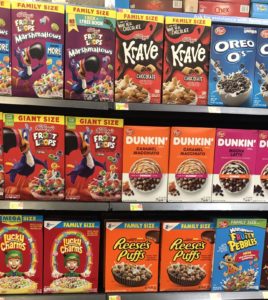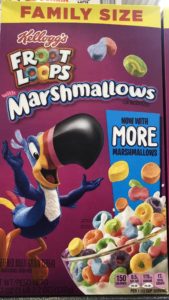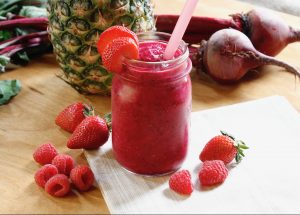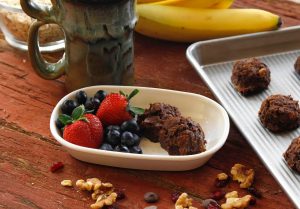 As we have mentioned before, some of the food rules we love by Michael Pollan are:
As we have mentioned before, some of the food rules we love by Michael Pollan are:
“Buy items with fewer than 5 ingredients,”
“Don’t eat anything that your great-grandmother wouldn’t recognize as food,”
and “Avoid food products containing ingredients a third-grader cannot pronounce.”
Another good one is:
“Don’t eat breakfast cereals that change the color of the milk.”
 The box says, “They’re magically delicious!” and it’s true…some cereal manufacturing “magic” had to happen for them to be, dare we say, “delicious”?!
The box says, “They’re magically delicious!” and it’s true…some cereal manufacturing “magic” had to happen for them to be, dare we say, “delicious”?!
When you stop to think about it, breakfast cereals can be some of the worst processed foods, but we have a hard time letting go of Tony the Tiger, especially if kids are involved. They have been telling us for years and years they are “GREEAAAAT!” Another Michael Pollan rule: “Avoid foods you see advertised on television.”
“Coo-coo for Cocoa Puffs?” Not really.
We know this coaching tip is not going to win any popularity contests with the kids…or some adults for that matter! We have to admit we cringe every time someone tells us they didn’t have time to make anything for dinner, so they just had cereal! So, here we go…because our kids’ health (and our own health) is THAT important. For us, a couple of the hardest parts of transitioning to more REAL food involved switching to REAL maple syrup and saying goodbye to a couple of our pantry staples…Cookie Crisp and Lucky Charms. After focusing on and learning more about the ingredients, now we say, “why didn’t we make that change sooner?!”
“What are you eating? Nuttin’ honey.” Remember that one?
With some cereals, that is absolutely true – when it comes to nutrients. As with everything, it comes down to reading the ingredient labels. But the cereal labels are even trickier because they are loaded with “health claims” on the front of the box to convince us that they are good for us! Here are a few tips to read between the lines to decipher and understand what is going on inside the box:
 Look for whole grains. Don’t trust the claims on the front of the box! For example, even if it says “Made with whole grain” there may be very little whole grain. Another misleading claim is “More whole grain than any other ingredient.” Make sure to read the ingredients…in many cases, a processed grain or sugar is the second (and maybe third and fourth) ingredient. (In FrootLoops Marshmallow cereal, sugar is the first ingredient!) Remember, if it doesn’t say “whole,” it is likely processed!
Look for whole grains. Don’t trust the claims on the front of the box! For example, even if it says “Made with whole grain” there may be very little whole grain. Another misleading claim is “More whole grain than any other ingredient.” Make sure to read the ingredients…in many cases, a processed grain or sugar is the second (and maybe third and fourth) ingredient. (In FrootLoops Marshmallow cereal, sugar is the first ingredient!) Remember, if it doesn’t say “whole,” it is likely processed!
- Recognize the difference between natural fiber and added fiber. Fiber is often added to cereals so they can be marketed as high in fiber – the problem is they are often still loaded with sugar. Whole grain fiber is useful in many ways including digestive and cardiovascular health. It also contributes to lower disease rates and helps control blood sugar. However, the added fibers in many processed foods haven’t been proven to provide these same health benefits. You may recognize these added fibers on the ingredient label as oat fiber, soy fiber and corn fiber, among others.
- Look at the sugar AND the serving size! For example, Cinnamon Toast Crunch has 9 grams of sugar for a 31g serving size, which is ¾ cup. Almost 30% of the bowl is sugar! A typical bowl of cereal is at least 1 ½ cups (trust us, ¾ cup is not much!) So, now you are looking at 18 grams of sugar. With 4 grams of sugar in 1 teaspoon, this is like eating almost 5 tsp of sugar! WOW! This is comparable to eating a handful of Starburst, a Twinkie or 4 Oreo cookies – it has the same amount of sugar! We read that General Mills says kids wouldn’t like their cereals if they reduced the sugar any more than they have in the past few years. Would that be such a bad thing?
- Pay attention to natural sugar vs. added sugar. Not all sugars are created equal. For example, if sugar, fructose, or artificial sweeteners are listed in the ingredients, they have added sugar to get that “magically delicious” taste. But, some cereals contain REAL fruit, which have natural sugar, which is perfectly acceptable. For example, if you read the label on many varieties of Muesli, most or all of it comes naturally from raisins, dates or other dried fruits and there are little – or no – added sugars. The Nutrition Facts label is finally improving to list not only Total Sugars, but also Added Sugars, so it’s no longer a mystery how much sugar they have added. A good goal is no more than 8 grams of added sugar, and at least 3 grams of fiber. Of course less sugar and more fiber is even better, but these two numbers are a good starting point.
- Beware of “fake fruits” and yogurt clusters. If the cereal has fruit, read the ingredient label to find the REAL fruit! In some cases, it might just be a combination of artificial ingredients (including coloring and flavoring) to create the “fruit” – YUMMY right?! If you enjoy cereal with fruit, the best bet is to add fresh fruit yourself. The same is true for those yogurt clusters…make sure it isn’t just a combination of oil, sugar and artificial ingredients.
What can you do?
So, now you are probably thinking…great, some of our favorite breakfast cereals are bad for us, so what can we do for a quick and healthy breakfast? While not as good as REAL food, there are some cereals that are decent alternatives such as Cheerios, some Nature’s Path cereals, Post Bran Flakes, Kashi Go Lean, some of the Cascadian Farms cereals, and others – just remember to read the ingredients!
For an EVEN BETTER breakfast try to focus on REAL food options such as:
 Smoothies – you can get creative and put together your favorite combination using our simple smoothie formula!
Smoothies – you can get creative and put together your favorite combination using our simple smoothie formula!- Mini frittatas – you can make them ahead of time in muffin pans, and then you are ready to warm, grab and go!
- Overnight oats – you can whip this up the night before, put it in the refrigerator and it is ready to go by morning! Baked Oatmeal Cups are another great option!
- Mug O’ Eggs – if you don’t have time for an omelet, you can still have delicious eggs and veggies in less than 3 minutes!
- DIY granola – yes, granola can be super-healthy, especially if you make it yourself. Feel free to pair it with milk, yogurt or fruit!
- Cookies for breakfast – with the right ingredients, you can enjoy a couple Chocolate Bliss Breakfast Cookies or Chunky Monkey Breakfast Cookies to get your day off to a great start…they go great with coffee!
 Leftovers –who says you can’t have leftovers for breakfast? Many leftovers from dinner the night before can be fantastic with a runny egg on top! The Chorizo Sweet Potato Tostadas are a great example! You can also wrap up your leftovers into some grab-and-go breakfast burritos!
Leftovers –who says you can’t have leftovers for breakfast? Many leftovers from dinner the night before can be fantastic with a runny egg on top! The Chorizo Sweet Potato Tostadas are a great example! You can also wrap up your leftovers into some grab-and-go breakfast burritos!
Now that you are armed with more label reading ammunition, you can ease yourself and your family into healthier – and tastier – options. We know some of these transitions to more REAL food can be challenging so don’t feel like this has to be an overnight change. REAL change takes time, but change doesn’t happen without action!
Let us know your breakfast successes and challenges!
“If we don’t change, we don’t grow. If we don’t grow, we aren’t really living.” – Gail Sheehy
 LEARN MORE ABOUT THE NAPKIN!
LEARN MORE ABOUT THE NAPKIN!



Leave A Comment